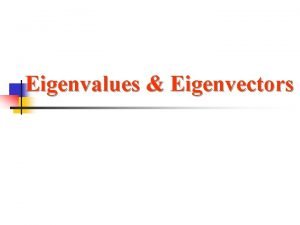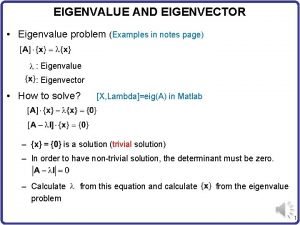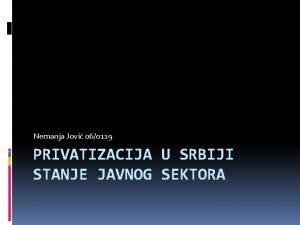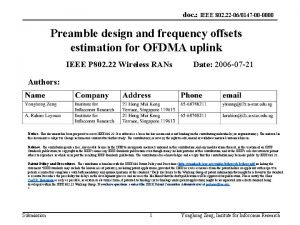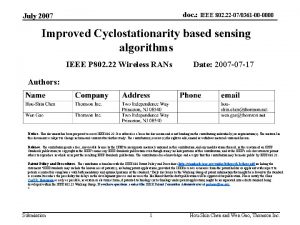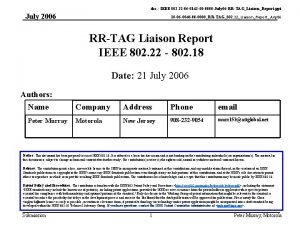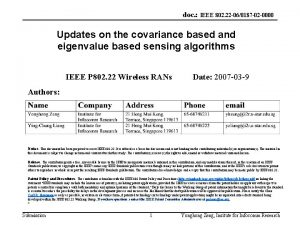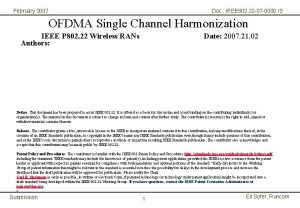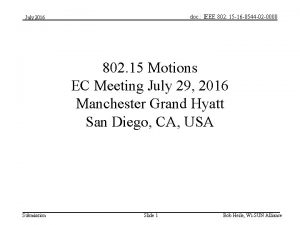doc IEEE 802 22 060119 00 0000 Eigenvalue













- Slides: 13

doc. : IEEE 802. 22 -06/0119 -00 -0000 Eigenvalue based sensing algorithms IEEE P 802. 22 Wireless RANs Date: 2006 -07 -14 Authors: Notice: This document has been prepared to assist IEEE 802. 22. It is offered as a basis for discussion and is not binding on the contributing individual(s) or organization(s). The material in this document is subject to change in form and content after further study. The contributor(s) reserve(s) the right to add, amend or withdraw material contained herein. Release: The contributor grants a free, irrevocable license to the IEEE to incorporate material contained in this contribution, and any modifications thereof, in the creation of an IEEE Standards publication; to copyright in the IEEE’s name any IEEE Standards publication even though it may include portions of this contribution; and at the IEEE’s sole discretion to permit others to reproduce in whole or in part the resulting IEEE Standards publication. The contributor also acknowledges and accepts that this contribution may be made public by IEEE 802. 22. Patent Policy and Procedures: The contributor is familiar with the IEEE 802 Patent Policy and Procedures http: //standards. ieee. org/guides/bylaws/sb-bylaws. pdf including the statement "IEEE standards may include the known use of patent(s), including patent applications, provided the IEEE receives assurance from the patent holder or applicant with respect to patents essential for compliance with both mandatory and optional portions of the standard. " Early disclosure to the Working Group of patent information that might be relevant to the standard is essential to reduce the possibility for delays in the development process and increase the likelihood that the draft publication will be approved for publication. Please notify the Chair Carl R. Stevenson as early as possible, in written or electronic form, if patented technology (or technology under patent application) might be incorporated into a draft standard being developed within the IEEE 802. 22 Working Group. If you have questions, contact the IEEE Patent Committee Administrator at patcom@iee. org. > Submission 1 Yonghong Zeng, Insitute for Infocomm Research

doc. : IEEE 802. 22 -06/0119 -00 -0000 Abstract • A sensing algorithm using the eigenvalues of the sample covariance matrix is proposed; • A close-form expression of the threshold is given based on random matrix theories (RMT); • The probability of false alarm is found by using the RMT; • The method can be used without knowledge of the signal, the channel and noise power; • Simulation results based on the captured DTV signals are presented; • Comparison with the energy detection is given. Submission 2 Yonghong Zeng, Insitute for Infocomm Research

doc. : IEEE 802. 22 -06/0119 -00 -0000 Figure 1. Flow-chart of the maximum-minimum eigenvalue (MME) detection Collect signal samples Compute the maximum eigenvalue and minimum eigenvalue of the covariance matrix Submission Compute threshold r Compute the sample covariance matrix using the collected samples Decision: if the maximum eign >r*minimum eign, signal exists; Otherwise, signal not exists. 3 Yonghong Zeng, Insitute for Infocomm Research

doc. : IEEE 802. 22 -06/0119 -00 -0000 Maximum-minimum eigenvalue (MME) detection Computation of the sample covariance matrix and the threshold is given in the following. Computation of the sample covariance matrix Submission 4 Yonghong Zeng, Insitute for Infocomm Research

doc. : IEEE 802. 22 -06/0119 -00 -0000 Maximum-minimum eigenvalue (MME) detection Computation of the threshold where Ns is the number of collected samples, M is the oversampling factor, L is the smoothing factor, F 1 is the Tracy-Wisdom distribution of order 1 and P 0 is the required probability of false alarm. Submission 5 Yonghong Zeng, Insitute for Infocomm Research

doc. : IEEE 802. 22 -06/0119 -00 -0000 Maximum-minimum eigenvalue (MME) detection The values of the Tracy-Wisdom distribution is given in Table 1. t -3. 90 -3. 18 -2. 78 -1. 91 -1. 27 -0. 59 0. 45 0. 98 2. 02 F 1(t) 0. 01 0. 05 0. 10 0. 30 0. 50 0. 70 0. 95 0. 99 Table 1: Numerical table for the Tracy-Wisdom distribution of order 1 Submission 6 Yonghong Zeng, Insitute for Infocomm Research

doc. : IEEE 802. 22 -06/0119 -00 -0000 Simulations and conclusions • The simulations are based on the captured DTV signals. The oversampling factor is M=2. The smoothing factor is chosen as L=8. White noises are added to obtain the various SNR levels. The number of samples used is 20000 (corresponding to 0. 93 ms). • Figure 2 gives the probability of detection results based on the DTV signal WAS-003/27/01 (at Washington D. C. , the receiver is outside and 48. 41 miles from the DTV station). Figure 3 gives the results based on the DTV signal NYC/200/44/01 (at New York, the receiver is indoor and 2 miles from the DTV station). • Table 2 gives the probability of false alarm of the methods. Submission 7 Yonghong Zeng, Insitute for Infocomm Research

doc. : IEEE 802. 22 -06/0119 -00 -0000 Simulations and conclusions Notations used in the figures and table: EG: energy detection. EG-xd. B: energy detection with xd. B noise uncertainty. MME: maximum-minimum eigenvalue detection Submission 8 Yonghong Zeng, Insitute for Infocomm Research

doc. : IEEE 802. 22 -06/0119 -00 -0000 Figure 2. Probability of detection based on the DTV signal WAS-003/27/01 Submission 9 Yonghong Zeng, Insitute for Infocomm Research

doc. : IEEE 802. 22 -06/0119 -00 -0000 Figure 3. Probability of detection based on the DTV signal NYC/200/44/01 Submission 10 Yonghong Zeng, Insitute for Infocomm Research

doc. : IEEE 802. 22 -06/0119 -00 -0000 Table 2: Probability of false alarm EG-2 d. B EG-1. 5 d. B EG-1 d. B EG-0. 5 d. B EG-0 d. B (no uncertainty) MME 0. 479 0. 474 0. 441 0. 473 0. 094 0. 089 Submission 11 Yonghong Zeng, Insitute for Infocomm Research

doc. : IEEE 802. 22 -06/0119 -00 -0000 Conclusions • Energy detection with noise uncertainty will result in high probability of false alarm and low probability of detection at low SNR; • The MME detection does not need any information on the noise level and SNR. It overcomes the noise uncertainty difficulty while keeps the advantages of the energy detection. The method can be used for signal detection without knowledge of the signal, the channel and noise power. Submission 12 Yonghong Zeng, Insitute for Infocomm Research

doc. : IEEE 802. 22 -06/0119 -00 -0000 References 1. A. Sahai and D. Cabric, “Spectrum sensing: fundamental limits and practical challenges, ” in Dyspan 2005 (available at: www. eecs. berkeley. edu/∼sahai), 2005. 2. Steve Shellhammer et al. , “Spectrum sensing simulation model”, http: //grouper. ieee. org/groups/802/22/Meeting_documents/2006_July/22 -06 -0028 -070000 -Spectrum-Sensing-Simulation-Model. doc , July 2006. 3. Steve Shellhammer, “Numerical spectrum sensing requirements”, http: //grouper. ieee. org/groups/802/22/Meeting_documents/2006_July/22 -06 -0088 -000000 -Numerical-Spectrum-Sensing-Requirements. doc, July 2006. 4. I. M. Johnstone, “On the distribution of the largest eigenvalue in principle components analysis, ” The Annals of Statistics, vol. 29, no. 2, pp. 295— 327, 2001. 5. Victor Tawil, “ 51 captured DTV signal”, http: //grouper. ieee. org/groups/802/22/Meeting_documents/2006_May/Informal_Docum ents, May 2006. Submission 13 Yonghong Zeng, Insitute for Infocomm Research












